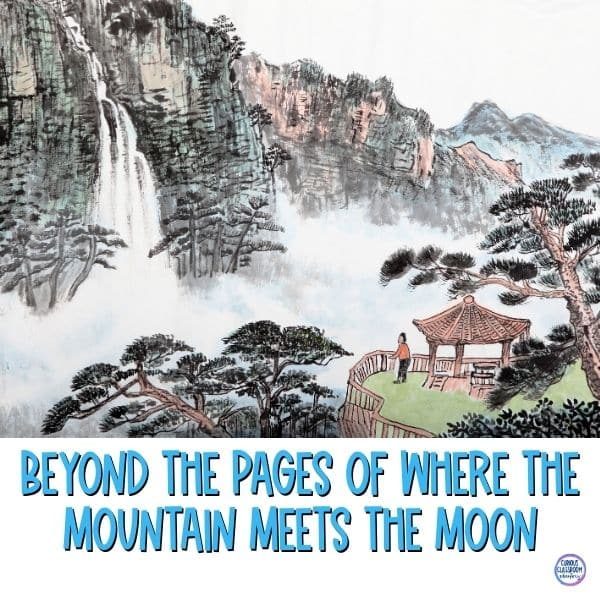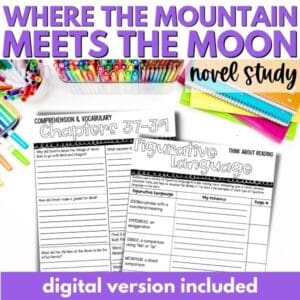Without a doubt, Where the Mountain Meets the Moon is my favorite book to teach! It is so full of rich vocabulary, legends and folktales, and heart warming themes! Grace Lin beautifully wove this tale that follows Minli, a young girl who embarks on a fantastical journey to change her family’s fortune. Along the way, she meets various characters and mythical creatures and learns valuable life lessons. The story, rich in Chinese folklore and beautifully illustrated, captures the imagination and teaches the importance of gratitude, family, and perseverance.
Activities for the Classroom:
Novel Study:
To keep students engaged throughout the entire novel, consider implementing a comprehensive novel study for Where the Mountain Meets the Moon. This could include chapter summaries, discussion questions, and vocabulary activities. Here are some components of my favorite novel study:
- Chapter Comprehension and Discussions:
- After reading each chapter, have students answer some deep-thinking comprehension questions. Follow this with a class discussion to explore key themes, character development, and plot progression.
- Vocabulary Building:
- Identify challenging words from each chapter (and there are a ton) to create vocabulary lists and look up the definitions. You can extend the vocabulary activities by having students learn and use these words in sentences, draw them, or create vocabulary flashcards.
- Reading Activities:
- This novels study as more reading skill pages than you’ll need so you can pick and choose what you need. Whether you want to go deeper with figurative language, cause and effect, or charactarizaiton you’ll be ready to go!
- Writing Prompts:
- One of the best ways to get students to connect with what they are reading is to have them write about it, and this novel study has prompts for narrative, persuasive, how-to, letter writing, and responding to meaningful sections of the book.
Create a Story Quilt:
- In the story, Minli’s journey is influenced by various stories she hears. Have students create a story quilt where each square represents a different story or significant event from the book. Students can draw or write in each square, and the quilt can be displayed in the classroom.
Art and Culture Exploration:
Grace Lin’s illustrations and the Chinese cultural elements in Where the Mountain Meets the Moon provide a great opportunity for an art and culture exploration activity.
-
Chinese Folklore Research:
-
- Assign each student a different Chinese folk tale to research and present to the class. They can compare these stories to the ones Minli encounters.
-
Art Project:
-
- Have students create their own illustrations inspired by the book’s art style. They could draw scenes, characters, or even create their own mythical creatures.
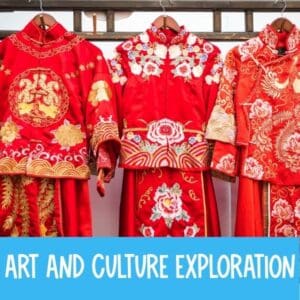
Geography and Mapping Activity:
In Where the Mountain Meets the Moon, Minli’s journey takes her across various landscapes. Use this as an opportunity to integrate geography into your lesson.
-
Create a Map:
- Have students draw a map of Minli’s journey, marking significant locations she visits. Include geographical features and have them write brief descriptions of each location.
-
Geographical Comparison:
- Compare the fictional locations in the book with real places in China. This can help students learn about Chinese geography and culture.
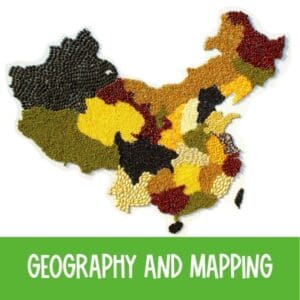
Culminating Activity – A Celebration of Stories:
At the end of the Where the Mountain Meets the Moon celebrate the completion with a storytelling festival.
-
Storytelling Festival:
- Have students pick their favorite story from the book and retell it in their own words. They can use props, costumes, or create simple puppets to enhance their storytelling.
-
Gratitude Reflection:
- Minli learns the importance of gratitude throughout her journey. Have students write a reflection on what they are grateful for in their own lives and share these with the class.
Integrate Science – Dragon Study:
The dragon is an important character in Where the Mountain Meets the Moon. Use this as a springboard for a science lesson.
-
Dragon Myth vs. Reality:
- Research the mythological dragon in Chinese culture and compare it with real-life reptiles such as a bearded dragon. Students can create a Venn diagram to show similarities and differences.
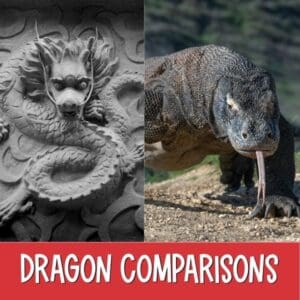
By incorporating these fun and educational activities into your classroom, you can bring Where the Mountain Meets the Moon to life for your students. These activities not only enhance their understanding of the book but also provide a rich, multidisciplinary learning experience.

